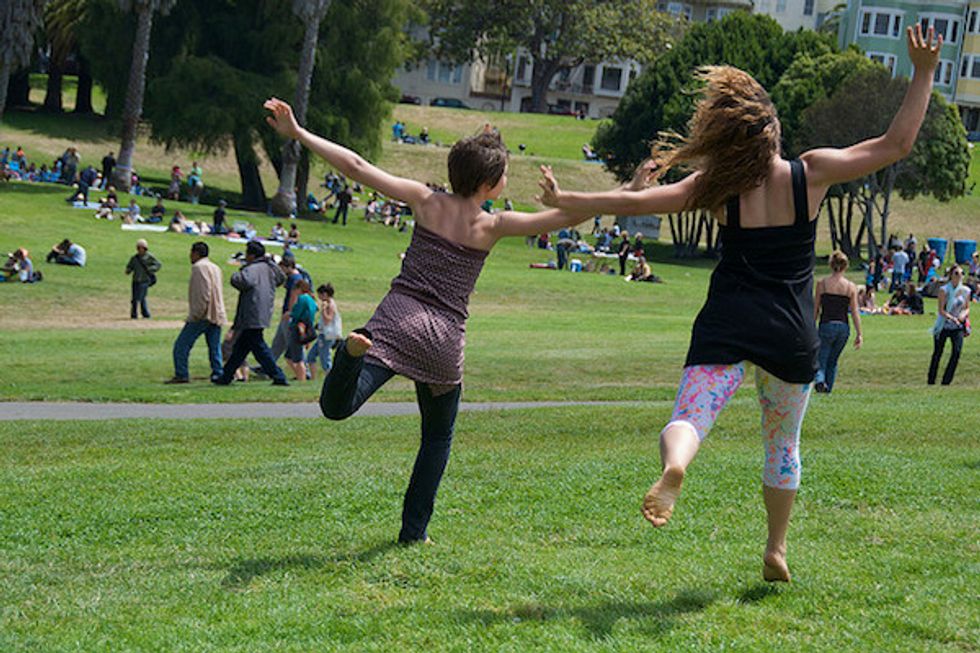Not to be confused with the envious ability to prance around in green tights while singing Comden & Green ditties à la Mary Martin, Peter Pan Syndrome is an unofficial diagnosis/official phenomenon used for men—San Francisco men in particular—who still act like boys. Dudes who refuse to grow up. And by growing up, one can define the tricky term thusly: trading hoodies for suit jackets, getting married, cranking out a few kids, and/or entering into something called “escrow.” You won't find much of these goings-on here in the city. While SF's obsession with youth has turned off many, is it really such a bad thing? Not really.
Stemming from the Latin term puer aeternus (meaning "eternal boy"), Peter Pan Syndrome (PPS) first came to light in Dr. Dan Kiley's 1983 book, The Peter Pan Syndrome: Men Who Have Never Grown Up. Flash forward to 2015 and this “condition,” has been used as fodder for many thought pieces, with SF techies being the modern day target. Back in the day, PPS could have been the diagnosis of choice for those damned hippies and my gay male brethren. If you think about it, their refusal to grow up has helped us grow as a city.
The spliff-smoking boomers of yesteryear—the first 20th century population to rebel against sharp haircuts and doing whatever The Man decried—vowed not to trust anyone over the age of 40. Droves of these hairy, scantily clad, beasts flocked to Baghdad by the Bay to buck the system and fight getting older. Thanks to their youthful rebellion—what would come to be known in the public lexicon as “counterculture”—the city's reputation as a bastion of progressive thought and free-flowing liberalism was cemented. And while that movement is now a shadow of its former self—save for a drum circle, one rarely sees an authentic hippie these days—it did pave the way for another important moment.
The Castro in the 1970s was, in part, responsible for a powerful civil rights movement that reverberated around the world. Harvey Milk. Sylvester. Gay Freedom Day. Poppers. No need to grow up when there were rollicking bathhouses and queer discos in almost every neighborhood. The ‘70s in SF were perfect for Peter Pans of every ilk to arrive en masse with tight jeans and handlebar moustaches, ready to live a life of gaiety and freedom. Years later, though, the community had to consider the possibility of growing up after marriage equality reared its head. Suddenly, your show tune-crooning buddy and his effeminate betrothed moved to Orinda, more concerned about getting a good mortgage rate than about tonight’s playlist at Martuni’s. But that youthful zest in the gay community, may it rest in peace, broke ground for the most recent wave of gangly nerds.
Enter tech, the latest members of the PPS club: Boys, some as young as 18, arrive to SF, ready to make millions creating the next big thing. This is a group prized not just for their fresh look (many tech ilk start getting Botox treatments as early as 25 years old), but for acting their age, minus five years. The zippy skateboard commute, the mandatory hoodies, the self-consciously dopey attitude that intentionally hints at autistic brilliance—it all happens under the glistening tech dome.
And what if, all this time, we've been growing up too early? According to a 2013 BBC article, adolescence can be broken into three stages: 12-14 years (early adolescence), 15-17 years (mid adolescence), and 18 years and over (late adolescence). Child psychologist Laverne Antrobus, of London's Tavistock Clinic, argues that the age of adulthood should be bumped from 18 to 25.
Antrobus says, "Neuroscience has made these massive advances…[there’s] actually evidence of brain development well into early twenties and that actually the time at which [this development] stops is much later than we first thought."
How does this bode for romance? Daisy Barringer, San Francisco native and editor at Thrillist, who often writes about her own romantic exploits in the city, explains that, while there are pitfalls in dating these perma-collegiates (namely, the lack of follow-through and commitment), it's better than hooking up with some accountant from Walnut Creek. "I admit that I am more attracted to guys with a younger vibe about them, which doesn't really bother me."
If growing up is not a requirement for success, why do it? SF has a long history of being the perfect breeding ground for PPS. Many new tech jobs allow for major flexibility, so these kids are making money—lots of it—but they’re also surfing, playing Smite at work, and shooting bottomless Fernet on the weekdays. But PPS isn’t just for men anymore. Women are—finally—getting in on the bacchanalia of arrested development. Because this isn’t just about the guys who work in tech, but the way the tech industry has paved our streets with gold, and gilded residential towers (ahem, Nema), making it so that even people in their 30s, regardless of gender, are living like post-collegiates.
“To be honest, I’m no Wendy Darling,” Barringer adds. “Being a Lost Boy sounds like a lot more fun than churning out babies."





















